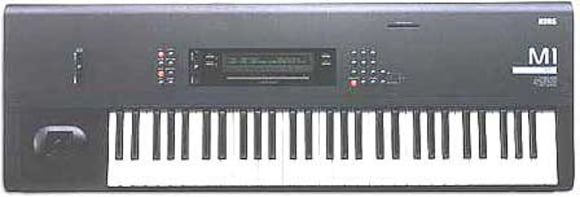2. History
Although the details vary from manufacturer to manufacturer, the key elements of a workstation consist of a keyboard, a synthesizer/sampler with drum sounds, a multitrack sequencer, and an effects processor. The quality of the keyboard, range of sounds and the complexity of the song writing facilities may well vary according to price, but if an instrument has all these features then it is considered a workstation.
The concept of the affordable workstation began in the late 80s when Korg released the M1. This had all the basic ingredients combined into one instrument, for not much more than the price of a regular keyboard of the day. Although the sequencer, with its rather limited note capacity, was more useful for demonstrating the M1s multitimbral preset sounds, it was an instant success, both in the studio and on stage, and showed the way forward. Until then, each component of an equivalent set-up represented a separate hardware unit, but Korg, taking advantage of newly available VLSI (Very Large Scale Integration) chips were able to combine all these elements into a single mid-sized keyboard, squeezing in PCM samples, multitimbrality, a 10,000 note sequencer, and digital effects - the workstation was born!

Korg M1 Workstation Keyboard
Over the years, keyboard workstations have grown bigger at least in terms of features - and better as the progress of digital technology has brought faster CPUs and DSP chips. Rather than a minimal LCD character display, todays models often feature full-colour touch-screens which allow you to quickly access parameters and move on-screen faders with the drag of a finger. PCM sample ROMs in the even the cheapest workstations now come with at least 8 times the M1s memory, and with sounds recorded at much higher sample and bit rates. On the performance side, additional controllers such as touch pads for triggering drums and synth phrases have further expanded the workstations capabilities far beyond its original concept.
The continued popularity of the workstation stems in large part from the freedom it gives you to compose without needing to switch on a computer or any other gear, maintaining the spontaneity of the moment by keeping all you need immediately to hand. For live performance, the workstation provides the gigging musician with a large palette of sounds, sweetened by built-in effects and a sturdy weighted keyboard that will withstand the rigours of the road. Large live keyboard arrangements are often performed by a sequencer with only one part actually being played by hand on the night even modern computers crash from time to time, and so workstations built-in sequencers are often relied on to perform this task. And if cover versions are your bag, then most instruments will import commercial MIDI files to enable you to reproduce your backing with great accuracy.


